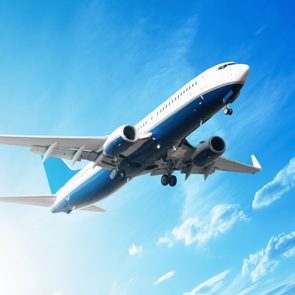Ever wondered about those white streaks trailing planes across the sky? Experts explain how these contrails form and what every traveler should know about their impact on our planet.

What Are the White Trails Behind Planes?

If you’ve ever glanced at the sky while an airplane flew overhead, you’ve no doubt seen the white trail following in its wake. Appearing like long, white clouds, these streaks are known as contrails, and they’re such a common aviation occurrence that most of us don’t blink twice when we see them in the sky. But what are contrails, exactly?
Contrails are more than just a byproduct of aviation—they’re a visible reminder of the complex relationship between air travel and our planet’s climate. As a travel journalist, I’ve spent years exploring the world, often marveling at the beauty of these trails, unaware of their deeper implications. But recent research has shed light on the environmental impact of contrails, urging us to reconsider our approach to air travel.
Read on for some fascinating airplane facts, including what contrails are, what a new study says about their impact on the environment and what researchers, airlines and travelers can do about it.
Get Reader’s Digest’s Read Up newsletter for more travel, tech, humor and fun facts all week long.
What are contrails?
Contrails, short for condensation trails, form when the hot, moist exhaust from an airplane’s engine meets the cold, low-pressure atmosphere at high altitudes. This process causes the water vapor in the exhaust to condense around tiny soot particles, forming ice crystals that create the visible white streaks we see in the sky. These trails can either dissipate quickly or linger, depending on the atmospheric conditions.
Several factors influence the formation of contrails, including the type of aircraft engine and the amount of soot produced. Modern engines, designed to be more fuel efficient, emit fewer soot particles, which can reduce the life span of contrails. However, even with these advances, contrails can persist. And that’s a problem because research suggests they contribute to climate change by trapping heat in the Earth’s atmosphere.
Are contrails bad for the environment?
While contrails might appear harmless, they have a significant impact on our climate. In fact, contrails can cause more warming than the carbon dioxide (CO2) emitted by the aircraft itself. The ice crystals in contrails trap heat in the atmosphere, creating a greenhouse effect.
And according to research published this month in the journal Environmental Research Letters, contrails can cause as much warming as all of aviation’s CO2 emissions combined.
So what’s the solution?
The aviation industry is at a crossroads. As the world grapples with the urgent need to combat climate change, the focus has largely been on reducing CO2 emissions. But there’s hope on the horizon.
“The good news is that people are working hard to find ways to avoid forming contrails, and it looks like we might be able to reduce these effects more quickly than we can reduce CO2 emissions,” says Imperial College London’s Marc Stettler, PhD, one of the authors of the study. His optimistic outlook is supported by research that shows “contrail avoidance” could be a relatively quick and cost-effective measure to reduce aviation’s contribution to global warming.
Avoiding contrails
Steven Barrett, PhD, the regius professor of engineering at the University of Cambridge, explains that contrail avoidance is one of the most promising strategies for mitigating the impact of contrails. “Since CO2 is only half the climate challenge for aviation, it is important for the industry to also tackle contrails,” he says. “Waiting for new aircraft to enter the fleet is going to take a long time. So operational measures like contrail avoidance are the primary opportunity to do something on a faster timescale.”
This involves altering flight paths to avoid the cold, humid parts of the atmosphere where contrails are most likely to form. Remarkably, with just minimal adjustments to only 5% of flight paths, we could eliminate 80% of contrail-induced warming. In other words, only 1 in 20 flights would need to fly over, under or around areas of the sky predicted to produce harmful contrails.
Intelligent route planning is one of the key strategies being explored by experts. By avoiding the atmospheric conditions that lead to persistent contrails, airlines could significantly reduce their environmental impact. And the cost? According to studies, these adjustments would be relatively cheap, with a fleet-average cost of roughly $5 per flight.
Further research is underway to explore the effectiveness of contrail avoidance on a larger scale. Barrett mentions that he and many other researchers are focused on demonstrating this approach over the next couple of years. If successful, these measures could be rolled out more widely, offering a quicker way to reduce aviation’s environmental footprint.
Reducing soot emissions
Reducing soot emissions is another critical aspect. Soot particles serve as the nuclei for water vapor to condense and form contrails. By designing aircraft engines that burn fuel more efficiently and produce fewer soot particles, we can significantly shorten the life span of contrails, thereby reducing their warming effect. This approach, combined with intelligent route planning, represents a promising step toward minimizing the environmental impact of contrails.
What can you do?
As travelers, we have a role to play in this journey toward sustainability. While much of the change will come from the industry, there are things we can do to nudge them along and be more sustainable travelers overall.
Make your voice heard
Supporting airlines that prioritize contrail avoidance and lobbying for policies that address the full climate impact of aviation are crucial steps. As a polar bear researcher once told me when I asked what people could do to protect wildlife, “Tell people to vote!” Supporting political candidates and policies that prioritize climate action is essential for driving the changes needed in aviation and beyond.
Barrett underscores the urgency of this approach. “There’s a real need to move quickly to understand if contrail avoidance could be done at a large scale and to demonstrate if these benefits can be realized,” he says. “This needs public and political support.”
Reduce how much you fly
Edward Gryspeerdt, PhD, a researcher on the faculty of natural sciences at the Grantham Institute for Climate Change and one of the authors of the Environmental Research Letters study, adds that while reducing contrails is crucial, cutting down on flying altogether, where possible, is another important action. “For many shorter trips, particularly in Europe, trains can be a cheaper, faster and more environmentally friendly option,” he says.
Gryspeerdt’s work explores how contrails can serve as a “natural experiment” for understanding how human activities influence the formation of natural cirrus clouds. This research is crucial for deciphering the broader impact of human emissions on cloud properties and climate change.
Flying into the future
So what are contrails in the larger context of Earth’s environment? Those seemingly innocuous white trails in the sky are a visible reminder of the challenges and opportunities that lie ahead in the fight against climate change. As we look to the future, it’s clear that every aspect of our travels—down to the trails we leave behind in the sky—matters. By understanding the science behind contrails and advocating for solutions, we can all contribute to a more sustainable future for aviation and for the planet.
The next time you gaze up at the sky and see those familiar white streaks, remember: Each one tells a story—a story of exploration, of progress and of the ongoing quest to balance our love for travel with our responsibility to protect the world we cherish.
The trails we leave behind today will shape the skies of tomorrow. Let’s make sure they’re trails we can be proud of.
About the experts
|
Why trust us
At Reader’s Digest, we’re committed to producing high-quality content by writers with expertise and experience in their field in consultation with relevant, qualified experts. We rely on reputable primary sources, including government and professional organizations and academic institutions as well as our writers’ personal experiences where appropriate. We verify all facts and data, back them with credible sourcing and revisit them over time to ensure they remain accurate and up to date. For this piece on what contrails are, Lisa Niver tapped her experience as a travel journalist to ensure all information is accurate. Read more about our team, our contributors and our editorial policies.
Sources:
- Marc Stettler, PhD, reader in transport and the environment in the Department of Civil and Environmental Engineering at Imperial College London
- Steven Barrett, PhD, regius professor of engineering at the University of Cambridge
- Edward Gryspeerdt, PhD, researcher on the faculty of natural sciences at the Grantham Institute for Climate Change
- Environmental Research Letters: “Operational differences lead to longer lifetimes of satellite detectable contrails from more fuel efficient aircraft”
- Imperial College London: “9 things you can do about climate change”
- Reviate: “How contrails form and evolve”
- Clouds and Climate: “Are newer aircraft worse for the climate?”



